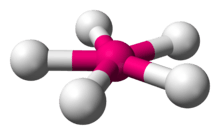Pentagonal planar molecular geometry
In chemistry, the pentagonal planar molecular geometry describes the shape of compounds where five atoms, groups of atoms, or ligands are arranged around a central atom, defining the vertices of a pentagon.

AX5E2
| Pentagonal planar molecular geometry | |
|---|---|
 | |
| Examples | XeF5− |
| Point group | D5h |
| Coordination number | 5 |
| Bond angle(s) | 72° |
| μ (Polarity) | 0 |
Examples
The only two pentagonal planar species known are the isoelectronic (nine valence electrons) ions XeF−
5 and IF2−
5.[1] Both are derived from the pentagonal bipyramid with two lone pairs occupying the apical positions and the five fluorine atoms all equatorial.
gollark: OIR:EM is currently playing the FTL soundtrack eternally on loop.
gollark: Yes.
gollark: It was mostly an afterthought to satisfy hæv.
gollark: I don't know. There's no web UI for the EM one.
gollark: It's like electronic (electric) music, but the modern understanding is that electricity and magnetism are unified under the electromagnetic force.
References
- Housecroft, C. E.; Sharpe, A. G. (2004). Inorganic Chemistry (2nd ed.). Prentice Hall. p. 498. ISBN 978-0130399137.
This article is issued from Wikipedia. The text is licensed under Creative Commons - Attribution - Sharealike. Additional terms may apply for the media files.